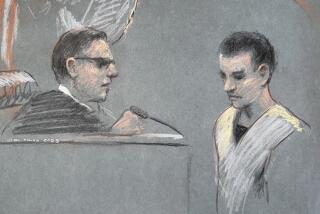Hall Says He Reported to Three Bosses: ‘Tinker, Evers, Chance’
- Share via
MANAGUA, Nicaragua — A self-styled American counterterrorist jailed for spying in Nicaragua said Monday that the Pentagon asked him in 1984 to form a paramilitary “foreign legion” to fight the Reagan Administration’s enemies around the world.
The prisoner, Sam Nesley Hall, said no such army was ever fielded. But he said three men known to him only by code names--Tinker, Evers and Chance--inherited the project and sent him on one-man missions to collect intelligence and advise the pro-U.S. rebels fighting Nicaragua’s leftist government.
Hall was arrested Dec. 12 at a restricted air base with three hand-drawn maps in his sock. Authorities here have said that he will be tried by a People’s Tribunal and will face up to 30 years in prison.
Hall, 49, an Air Force veteran and Olympic medalist from Dayton, Ohio, said the Pentagon and the CIA interviewed him on Nov. 24, 1984, about forming an American foreign legion. He would not say who arranged or conducted the interviews.
“I was told to go home and await word,” he said. “About Dec. 8 (1984), I was notified that I was picked to lead this independent army. It was supposed to be financed by independent money, and I was given $12,500 to go overseas with my contacts and put it together.”
After he had traveled six weeks and recruited 540 mercenaries for what was to be a Middle East-based “Phoenix Battalion,” Hall said, the Pentagon estimated that the project would cost at least $14 million a year and dropped it for lack of outside financing.
Sometime later, Hall said, he was asked to resume the project. He said he was told to report to three men code-named Tinker (in Washington), Evers (in London) and Chance (in Miami). Tinker, Evers and Chance were part of a legendary baseball infield of the Chicago Cubs in the early 1900s.
“I do not know if they were connected with the American government,” Hall said. “I am not working for the U.S. government that I know of. I can honestly say that. I told the (Nicaraguan) state security that I would be happy to take a polygraph. They can use (truth) serum on me if they want.”
On instructions from the man called Chance, Hall said he flew to Nicaragua on Dec. 10 to check reports that Cuban crews were assembling Soviet helicopters at the Punta Huete air base 13 miles northeast of Managua.
“I was also to see what kind of new construction was under way, such as fuel storage tanks,” he said.
Asked by whom and for what purpose this intelligence was to be used, Hall said: “I have no idea.”
Looking dour in a blue knit sport shirt and off-white jeans, Hall was taken from prison for 20 minutes of questioning by reporters Monday. His rambling, disjointed statements raised more questions than they answered about the Pentagon’s paramilitary project and his ill-fated mission in Nicaragua.
The U.S. Congress is investigating whether the Reagan Administration violated any laws by selling arms to Iran and allegedly siphoning profits to the rebels, known as contras , after Congress cut off the rebels’ U.S. military assistance in May, 1984. The aid was legally restored two months ago.
Trial as Terrorist
Nicaraguan President Daniel Ortega said last week that Hall would be tried as a terrorist working for U.S. government interests to overthrow the Sandinista regime.
Capt. Oscar Lopez, operations chief of the security police, escorted the prisoner to meet reporters at the headquarters of the presidential press office. Lopez showed reporters the dossier on Hall, entitled “The Rambo Case,” which contained three maps that he said Hall was carrying when arrested.
The most detailed map showed Puerto Cabezas, Nicaragua’s principal Caribbean port. It contained handwritten figures detailing estimates of “enemy strengths” in Nicaragua’s Caribbean region at 6,500 men, including Soviet and Cuban advisers.
The dossier said Hall also carried a pocket camera, binoculars and a card identifying him as a correspondent of an unnamed news organization.
More to Read
Sign up for Essential California
The most important California stories and recommendations in your inbox every morning.
You may occasionally receive promotional content from the Los Angeles Times.










